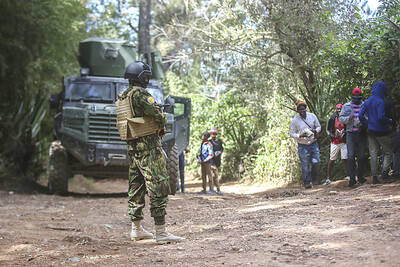Myanmar, already wracked by a brutal civil war, has regained the unenviable title of the world’s biggest opium producer, a UN agency report released yesterday showed.
The Southeast Asian country’s opium output has topped that of Afghanistan, where the ruling Taliban imposed a ban on its production, the UN Office on Drugs and Crime (UNODC) said in its Southeast Asia Opium Survey 2023.
The Taliban’s ban has led to a 95 percent drop in the cultivation of opium poppies, the agency said last month. Opium, the base from which morphine and heroin are produced, is harvested from poppy flowers.

Photo: AFP
From 2022-2023, Myanmar saw the estimated amount of land used to grow the illicit crop increase 18 percent to 47,100 hectares, the report said.
“Although the area under cultivation has not returned to historic peaks of nearly 58,000 ha [hectares] cultivated in 2013, after three consecutive years of increases, poppy cultivation in Myanmar is expanding and becoming more productive,” it said.
It added that the estimated opium yield expanded 16 percent to 22.9 kilograms per hectare — topping the previous record set last year.
It attributed that increase to “increasingly sophisticated means of cultivation, including increased plot density, improved organization of plants, and enhanced practices, such as the use of irrigation systems and potentially fertilizers,” it said.
The violent political turmoil in Myanmar has contributed to the opium production increase.
“The economic, security and governance disruptions that followed the military takeover of February 2021 continue to drive farmers in remote areas towards opium to make a living,” UNODC Regional Representative Jeremy Douglas said.
The report said that “opium poppy cultivation in Southeast Asia is closely linked to poverty, lack of government services, challenging macroeconomic environments, instability and insecurity.”
For farmers, the bottom line is simple economics.
The agency said the average price paid to opium growers increased 27 percent to about US$355 per kilogram, demonstrating the attractiveness of opium as a crop and commodity and strong demand.
The figures mean farmers earned about 75 percent more than in the previous year, it said.
Douglas said that armed conflict in Shan state in Myanmar’s northeast, a traditional growing region, and in other border areas “is expected to accelerate this trend.”
An offensive launched in late October by an alliance of three ethnic armed groups against Myanmar’s military government has further destabilized the remote region.
Northeastern Myanmar is part of the infamous “Golden Triangle,” where the borders of Myanmar, Laos and Thailand meet. The production of opium and heroin historically flourished there, largely because of the lawlessness in border areas where Myanmar’s central government has been able to exercise only minimum control over various ethnic minority militias, some of them partners in the drug trade.
In recent decades, as the region’s opium production dropped, methamphetamine in the form of tablets and crystal meth has supplanted it. It is easier to make on an industrial scale than the labor-intensive cultivation of opium, and gets distributed by land, sea and air around Asia and the Pacific.
UNODC said in a statement accompanying its report that the region’s burgeoning drug production “feeds into a growing illicit economy ... which brings together continued high levels of synthetic drug production and a convergence of drug trafficking, money laundering and online criminal activities including casinos and scam operations.”
Cyberscam operations, particularly in Myanmar’s border areas, have come under the spotlight for employing tens of thousands of people, many lured by false offers of legitimate employment and then forced to work in conditions of near slavery.
The recent fighting in Shan state is linked to efforts to eradicate the criminal networks running the scam operations and other illegal enterprises.

A French-Algerian man went on trial in France on Monday for burning to death his wife in 2021, a case that shocked the public and sparked heavy criticism of police for failing to take adequate measures to protect her. Mounir Boutaa, now 48, stalked his Algerian-born wife Chahinez Daoud following their separation, and even bought a van he parked outside her house near Bordeaux in southwestern France, which he used to watch her without being detected. On May 4, 2021, he attacked her in the street, shot her in both legs, poured gasoline on her and set her on fire. A neighbor hearing

DEATH CONSTANTLY LOOMING: Decades of detention took a major toll on Iwao Hakamada’s mental health, his lawyers describing him as ‘living in a world of fantasy’ A Japanese man wrongly convicted of murder who was the world’s longest-serving death row inmate has been awarded US$1.44 million in compensation, an official said yesterday. The payout represents ¥12,500 (US$83) for each day of the more than four decades that Iwao Hakamada spent in detention, most of it on death row when each day could have been his last. It is a record for compensation of this kind, Japanese media said. The former boxer, now 89, was exonerated last year of a 1966 quadruple murder after a tireless campaign by his sister and others. The case sparked scrutiny of the justice system in

DITCH TACTICS: Kenyan officers were on their way to rescue Haitian police stuck in a ditch suspected to have been deliberately dug by Haitian gang members A Kenyan policeman deployed in Haiti has gone missing after violent gangs attacked a group of officers on a rescue mission, a UN-backed multinational security mission said in a statement yesterday. The Kenyan officers on Tuesday were on their way to rescue Haitian police stuck in a ditch “suspected to have been deliberately dug by gangs,” the statement said, adding that “specialized teams have been deployed” to search for the missing officer. Local media outlets in Haiti reported that the officer had been killed and videos of a lifeless man clothed in Kenyan uniform were shared on social media. Gang violence has left

US Vice President J.D. Vance on Friday accused Denmark of not having done enough to protect Greenland, when he visited the strategically placed and resource-rich Danish territory coveted by US President Donald Trump. Vance made his comment during a trip to the Pituffik Space Base in northwestern Greenland, a visit viewed by Copenhagen and Nuuk as a provocation. “Our message to Denmark is very simple: You have not done a good job by the people of Greenland,” Vance told a news conference. “You have under-invested in the people of Greenland, and you have under-invested in the security architecture of this